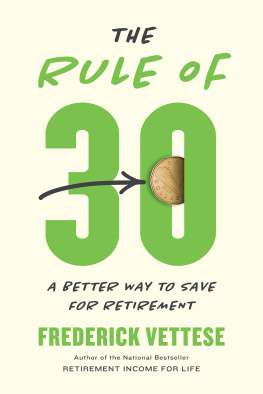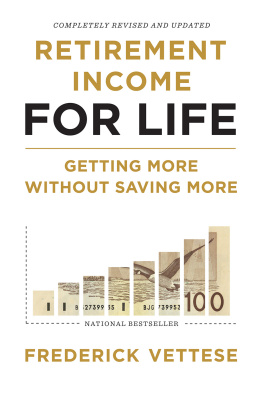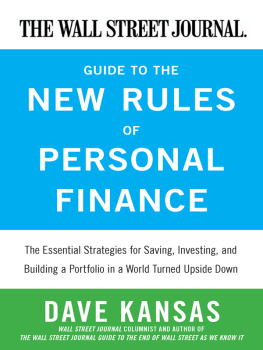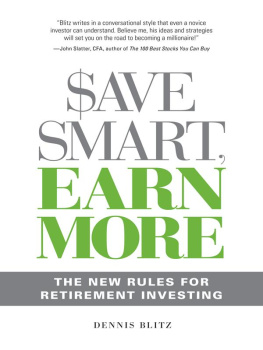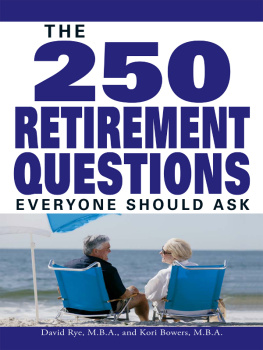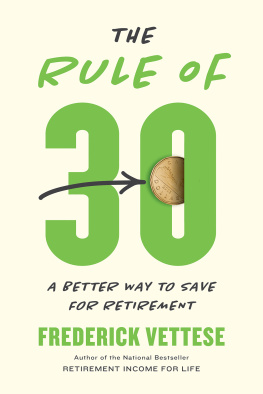The Rule of 30
A Better Way to Save for Retirement
Frederick Vettese
Contents
Dedication
To Gregory, Troy, Michael and Alex
List of Tables and Figures
List of Acronyms
The various retirement-related acronyms that are used throughout the text are all shown here, along with the chapter in which they first appear.
CPIConsumer Price Index for Canada ()
CPPCanada Pension Plan ()
CRACanada Revenue Agency ()
CCBCanada child benefit ()
DBdefined benefit, as in DB pension plan ()
DCdefined contribution, as in DC pension plan ()
EIEmployment Insurance ()
ERPequity risk premium ()
ETFexchange-traded fund ()
OASOld Age Security, usually in reference to OAS pension ()
QPPQuebec Pension Plan ()
P/Eprice to earnings (ratio) ()
PERCPersonal Enhanced Retirement Calculator ()
RESPRegistered Education Savings Plan ()
RRSPRegistered Retirement Savings Plan ()
RRIFRegistered Retirement Income Fund ()
TDFtarget date fund ()
TFSATax-Free Savings Account ()
Foreword
To say things have changed over the last few decades would be an understatement. For the most part, these changes are right before our eyes in the form of smartphones, connected cars, streaming content and nearly unlimited information at our fingertips. But some changes are not so obvious.
Consider saving for retirement. Between defined benefit pensions and high risk-free interest rates, preparing for retirement used to be easier from the individuals perspective. Unfortunately, defined benefit pensions are now virtually extinct, at least in the private sector, and real interest rates are essentially non-existent.
Among employers who do offer pension plans, the move from defined benefit to defined contribution plans has transferred much of the onus to individuals; and for the far too many Canadians who have no workplace coverage at all, the responsibility of saving for retirement is entirely theirs. This leaves the average individual more at the mercy of the capital markets than ever before. To see how this sea change affects saving for retirement, we must shed some old assumptions and look more closely under the hood. More than that, we must look closely at ourselves and our habits if we are going to be able to overcome the new financial challenges we face.
As the founder of Purpose Investments, cofounder of WealthSimple and someone who has dedicated my life to making investing more structured and accessible to Canadians, it goes without saying that I strongly believe in the importance of saving for retirement. This is what has attracted me to Freds thinking and work over the years. I have always found Fred to have a clear perspective on the challenges we face, as a society and as individuals, in thinking about and preparing for retirement.
But how do we get this clear thinking into the hands of every Canadian and then help them implement it? This book is a great start, whether you are a young professional beginning your career, or if you have just gotten over the daycare hump and your kids are now at the point where they are starting to realize you are not as cool as they once thought.
This book neatly frames the problem many young Canadians face in trying to figure out how much they should save each year. People generally understand that this is something important to do, whether it is an afterthought following the purchase of a home or a luxury item or a conscious question they ask themselves after they receive their first paycheque. But answering the question can involve so many variables that the task can feel overwhelming. With the time for retirement so far in the future, it is much too easy to defer answering the question until it is too late.
For most people, successfully saving for retirement is a matter of forming good habits. To do that, the importance of saving must be recognized and acted upon. And the earlier you do this the better, because time is your greatest ally in achieving your retirement goals. You do not even need to have specific goals to get started saving. You can decide how to live and spend your money further down the road. But if you do not save, you will not have many options.
The Rule of 30, as Fred describes, solves this problem by providing a very thoughtful yet easy-to-follow framework for young Canadians. It allows them to take the first step to begin saving for retirement, regardless of their financial situation. The framework is flexible and adjusts to your life stage, taking into consideration both your current and potential future salary and expenses.
Once you are much closer to retirement, you will need to look more closely at your overall financial situation to define your retirement goals and to ultimately understand if you are ahead, on track or behind schedule for meeting them. When you reach that point you can make the appropriate tweaks, if required. But without a base of retirement savings gradually built up over the years, there will be nothing to tinker with and retirement may be an elusive goal.
Another hurdle to overcome is the expectation for returns on fixed-income securities. Thirty years ago, you could count on a 7 percent income in retirement simply through buying high-quality bonds. Today, that same portfolio would garner a return of under 2 percent, likely earning a negative return when inflation is taken into consideration.
One of the most dangerous things we can do when it comes to saving is to assume that what has worked in the past will work in the future. Commentators have been predicting a return to higher interest rates for years. As Fred argues in this book, it may be a very long time before that materializes, so we need to adjust our retirement and saving plans to present-day realities.
The Rule of 30 considers the current macro-economic environment and provides new ways for young Canadians to approach their asset allocation today. It is a valuable tool in helping to change the perception of retirement saving, as Fred offers new ways to approach the problem and build a solution. With Freds advice and insights, saving for retirement is easier than ever.
Get ready to take control of your situation and get started on ensuring you are on the right path to a well-planned and secure retirement.
Som Seif
Founder and CEO of Purpose Investments
PART I
Lessons from the Past
Chapter 1
How Much Should You Save?
Deciding how much to save for retirement sounds like a question that should have a ready answer, and yet, there is no apparent consensus. Ask different retirement experts and they will give you starkly different responses, or else none at all. While some variability is to be expected from one person to the next, surely there should be a rule of thumb.
Despite their obvious shortcomings, good rules of thumb have their uses. They resonate with people who do not have the time or interest to become subject experts. If a specific rule doesnt put them on precisely the best path, it at least ensures they do not stray too far.
I started on my quest for the ideal percentage to save by asking a group that I call the Shed. This is an informal group of now-retired pension luminaries (nearly all of them actuaries) who meet regularly to discuss the state of the world. When it comes to retirement issues, they once commanded the attention of Canadas biggest employers, both public and private. I reasoned that if anyone could tell me how much we should be saving, it would be them.

